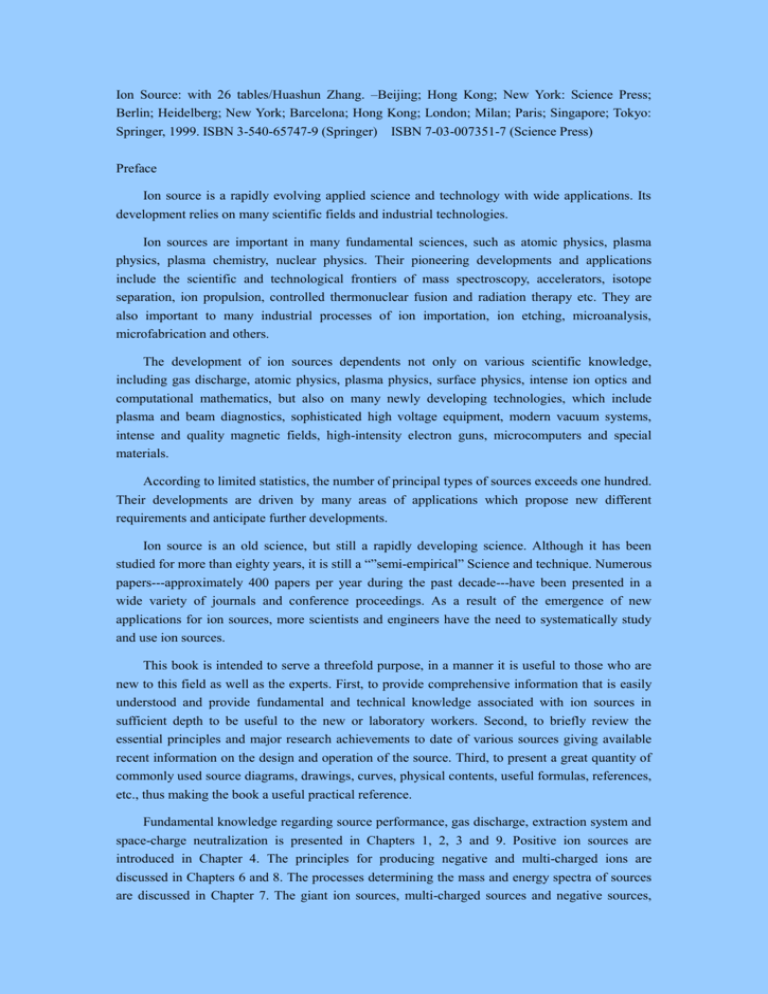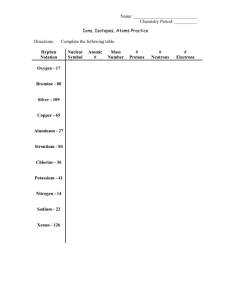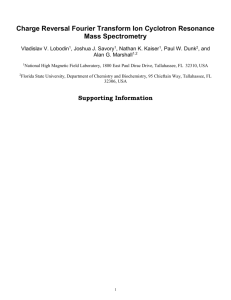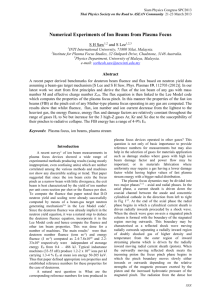Ion Source: with 26 tables/Huashun Zhang
advertisement

Ion Source: with 26 tables/Huashun Zhang. –Beijing; Hong Kong; New York: Science Press; Berlin; Heidelberg; New York; Barcelona; Hong Kong; London; Milan; Paris; Singapore; Tokyo: Springer, 1999. ISBN 3-540-65747-9 (Springer) ISBN 7-03-007351-7 (Science Press) Preface Ion source is a rapidly evolving applied science and technology with wide applications. Its development relies on many scientific fields and industrial technologies. Ion sources are important in many fundamental sciences, such as atomic physics, plasma physics, plasma chemistry, nuclear physics. Their pioneering developments and applications include the scientific and technological frontiers of mass spectroscopy, accelerators, isotope separation, ion propulsion, controlled thermonuclear fusion and radiation therapy etc. They are also important to many industrial processes of ion importation, ion etching, microanalysis, microfabrication and others. The development of ion sources dependents not only on various scientific knowledge, including gas discharge, atomic physics, plasma physics, surface physics, intense ion optics and computational mathematics, but also on many newly developing technologies, which include plasma and beam diagnostics, sophisticated high voltage equipment, modern vacuum systems, intense and quality magnetic fields, high-intensity electron guns, microcomputers and special materials. According to limited statistics, the number of principal types of sources exceeds one hundred. Their developments are driven by many areas of applications which propose new different requirements and anticipate further developments. Ion source is an old science, but still a rapidly developing science. Although it has been studied for more than eighty years, it is still a “”semi-empirical” Science and technique. Numerous papers---approximately 400 papers per year during the past decade---have been presented in a wide variety of journals and conference proceedings. As a result of the emergence of new applications for ion sources, more scientists and engineers have the need to systematically study and use ion sources. This book is intended to serve a threefold purpose, in a manner it is useful to those who are new to this field as well as the experts. First, to provide comprehensive information that is easily understood and provide fundamental and technical knowledge associated with ion sources in sufficient depth to be useful to the new or laboratory workers. Second, to briefly review the essential principles and major research achievements to date of various sources giving available recent information on the design and operation of the source. Third, to present a great quantity of commonly used source diagrams, drawings, curves, physical contents, useful formulas, references, etc., thus making the book a useful practical reference. Fundamental knowledge regarding source performance, gas discharge, extraction system and space-charge neutralization is presented in Chapters 1, 2, 3 and 9. Positive ion sources are introduced in Chapter 4. The principles for producing negative and multi-charged ions are discussed in Chapters 6 and 8. The processes determining the mass and energy spectra of sources are discussed in Chapter 7. The giant ion sources, multi-charged sources and negative sources, which have developed fastest during the past thirty years, are discussed in detail in Chapters 5, 6 and 8. Finally, beam diagnostic is introduced in Chapter 10. Many useful physical constants and data are given in the appendix. This book has extracted its contents form more than 4000 articles published in different journals and other publications, to avoid too much consumption of space only about one thousand foremost references, which are sufficient to guide the readers to further information on topics of particular interest, are given. The original manuscript of this book was written by Zhang Huashun based on his book, in Chinese, “Ion Source and Powerful Neutral Beam Injectors”. Parts of Chapters 2, 4 and 9 of the Chinese book were written by Wan Chunhou, likewise parts of Chapter 5 were written by Wang Gengjie. The author thanks Dr. P. Allison and K. Prelec for their encouragement for this English version. The English manuscript was extensively reviewed and reedited by Mr. C. W. Schmidt, who made a great contribution to the book quality. Thanks are due to many publishers, organizations and persons for permission to reproduce materials and figures from various books and journals.









